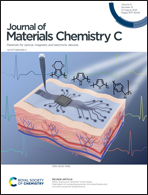Stabilizing TiO2/CH3NH3PbI3 heterostructure and enhancing interface trap passivation for efficient and stable perovskite solar cells†
Abstract
Because the heterostructure of soft perovskite possesses a weak bonding nature, the photovoltaic performance and stability of devices are limited by numerous under-coordinated ions (Pb2+ or CH3NH3+) or iodine vacancies at the TiO2/CH3NH3PbI3 interface. Herein, organic super-halide salt tetrabutylammonium borohydride (TABH) was introduced to the TiO2/CH3NH3PbI3 interface, and it impeded the movement of decomposed components from the soft CH3NH3PbI3 lattice and thus increased the trap passivation effect. As a result, there was an increase in the power conversion efficiency (PCE) from 18.2% to as high as 20.4% with suppressed hysteresis, which can be ascribed to the incorporated TABH-optimized energy level alignment and fewer iodine vacancies as well as traps. Furthermore, considering the strong chemical interactions of the Pb–BH4−t bond, the under-coordinated lead ions were stabilized by the incorporation of the TABH interlayer and were able to impede ion migration or volatilization, thereby enhancing the stability of perovskite solar cells (PSCs). More importantly, PSCs maintained 80% of their initial efficiency after storage for 1200 h in the ambient environment. This work provides a facile interface strategy that compensates for the intrinsic instability of soft perovskite's heterostructure and demonstrates the fabrication of highly efficient PSCs for further application.



 Please wait while we load your content...
Please wait while we load your content...